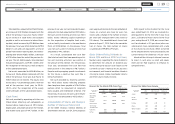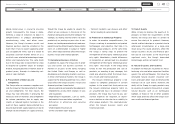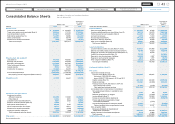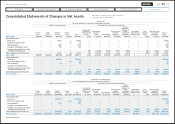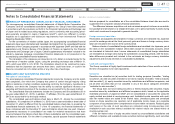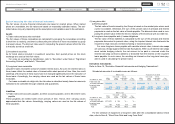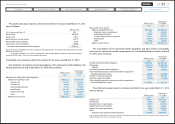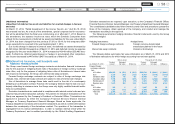Mazda 2014 Annual Report Download - page 51
Download and view the complete annual report
Please find page 51 of the 2014 Mazda annual report below. You can navigate through the pages in the report by either clicking on the pages listed below, or by using the keyword search tool below to find specific information within the annual report.
The Company and its wholly owned domestic subsidiaries elect to file a consolidated
corporate tax return as a consolidation group.
Research and development costs
Research and development costs are charged to income when incurred. For the years
ended March 31, 2014 and 2013, research and development costs were ¥99,363 million
($964,689 thousand) and ¥89,930 million, respectively.
Derivatives and hedge accounting
Derivative financial instruments are mainly stated at fair value, and changes in the fair
value are recognized as gains or losses unless derivative financial instruments are used
for hedging purposes and meet criteria for hedge accounting.
If derivative financial instruments are used as hedges and meet certain hedging criteria,
recognition of gains or losses resulting from changes in the fair value of derivative financial
instruments is deferred until the related losses or gains on the hedged items are recognized.
Also, if interest rate swap contracts are used as hedges and meet certain hedging
criteria, the net amount to be paid or received under the interest rate swap contract is
added to or deducted from the interest on the assets or liabilities for which the swap
contract was executed.
Amounts per share of common stock
The computations of net income or loss per share of common stock are based on the
average number of shares outstanding during each fiscal year. Diluted net income per
share of common stock is computed based on the average number of shares outstanding
during each fiscal year after giving effect to the diluting potential of common stock to be
issued upon the exercise of stock acquisition rights and stock options.
For the years ended March 31, 2014 and 2013, only information on net income per
share of common stock is provided without information on diluted net income per share of
common stock to reflect the diluting effect, because there were no dilutive potential
common stocks for the year ended March 31, 2014 and there were no dilutive potential
common stocks that have dilutive effects for the year ended March 31, 2013.
Cash dividends per share represent amounts applicable for the respective years on an
accrual basis.
Reclassifications
Certain amounts in the prior year’s consolidated financial statements have been reclassified
to conform to this year’s presentation.
3
ADOPTION OF NEW ACCOUNTING STANDARDS AND
ACCOUNTING CHANGES
(Changes in accounting policies)
Effective from the year ended March 31, 2014, the Domestic Companies have applied the
Accounting Standard for Retirement Benefits (Accounting Standards Board of Japan
(“ASBJ”) Statement No.26, May 17, 2012 (hereinafter, the “Statement No.26”)) and Guidance
on Accounting Standard for Retirement Benefits (ASBJ Guidance No.25, May 17, 2012
(hereinafter, the “Guidance No.25”)) except the article 35 of the Statement No.26 and the
article 67 of the Guidance No.25. As a result, actuarial gains and losses and past service
costs that are yet to be recognized have been recognized and the difference between retire-
ment benefit obligations and plan assets has been recognized as a liability for retirement
benefits. When pension assets exceed the retirement benefit obligations, its difference has
been recognized as an asset for retirement benefits.
In accordance with the article 37 of the Statement No.26, the effect of the change in
accounting policies arising from initial application has been recognized in accumulated
adjustments for retirement benefit in accumulated other comprehensive income.
As a result of the application, an asset for retirement benefits in the amount of ¥2,046
million ($19,864 thousand) and a liability for retirement benefits in the amount of ¥70,149
million ($681,058 thousand) have been recognized, accumulated other comprehensive
income has decreased by ¥3,844 million ($37,320 thousand), and minority interests in
consolidated subsidiaries has decreased by ¥105 million ($1,019 thousand), at the end of
the current fiscal year.
Along with the adoption of the new standards, the presentation of “Pension adjustments
recognized by foreign consolidated subsidiaries” in Consolidated Balance Sheets, Consolidated
Statements of Comprehensive Income, and Consolidated Statements of Changes in Net
Assets for previous fiscal year has been changed to “Accumulated adjustments for retire-
ment benefit” in Consolidated Balance Sheets and Consolidated Statements of Changes in
Net Assets, and “Adjustments for retirement benefit” in Consolidated Statements of
Comprehensive Income, respectively, from the fiscal year ended March 31, 2014.
(Accounting standards issued but not yet effective)
– Accounting Standard for Retirement Benefits (ASBJ Statement No.26, May 17, 2012)
–Guidance on Accounting Standard for Retirement Benefits (ASBJ Guidance No.25,
May 17, 2012)
(1) Summary
Under the amended rule, actuarial gains and losses and past service costs that are yet to
be recognized in profit or loss would be recognized within the net assets section, after
adjustment for tax effects, and the deficit or surplus would be recognized as a liability or
49
Mazda Annual Report 2014
CONTENTS
Foundations Underpinning
Sustainable Growth
Financial Section
Review of Operations
Message from Management
Introduction
Brand Value Management


